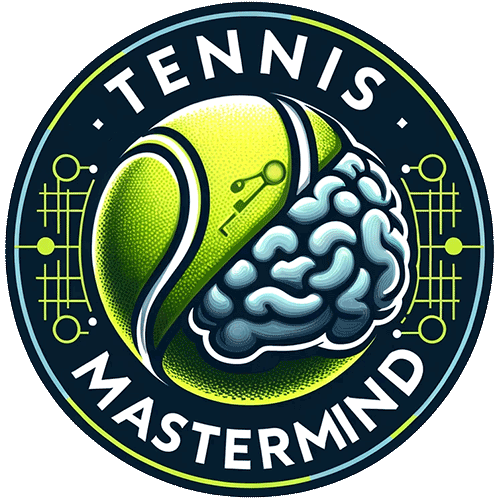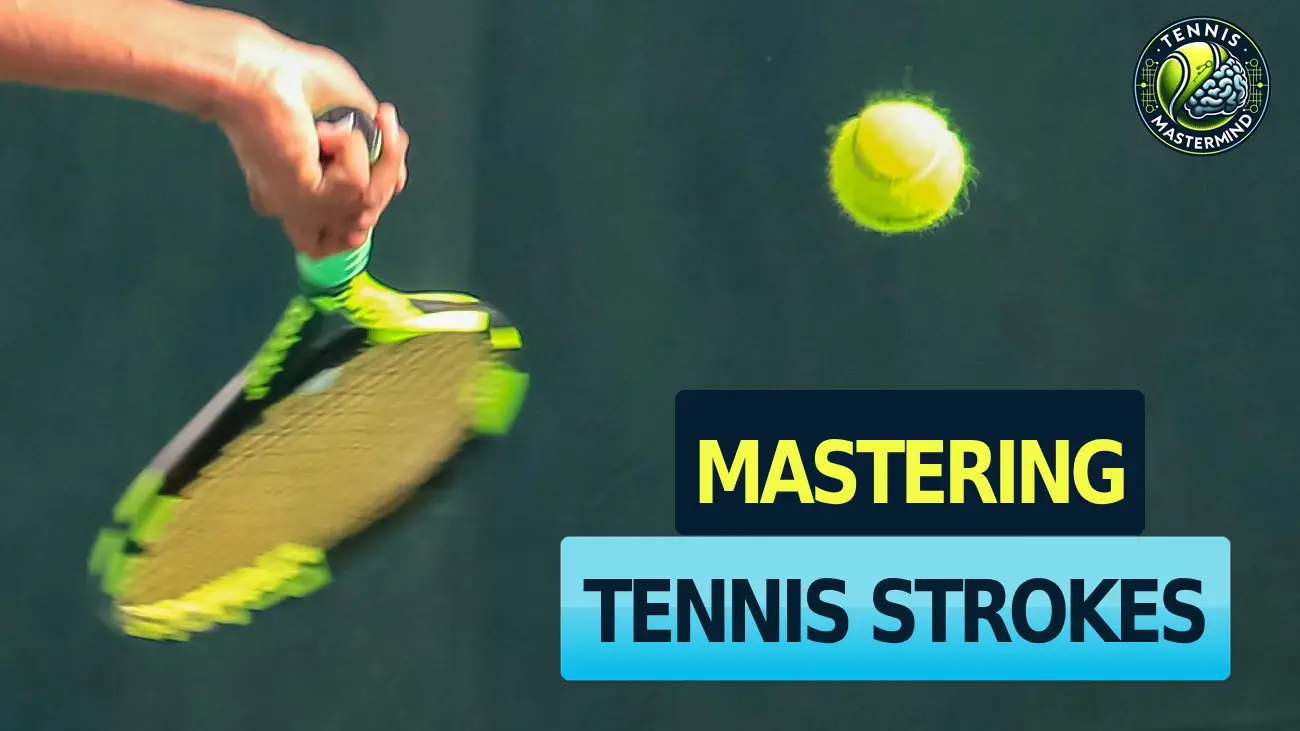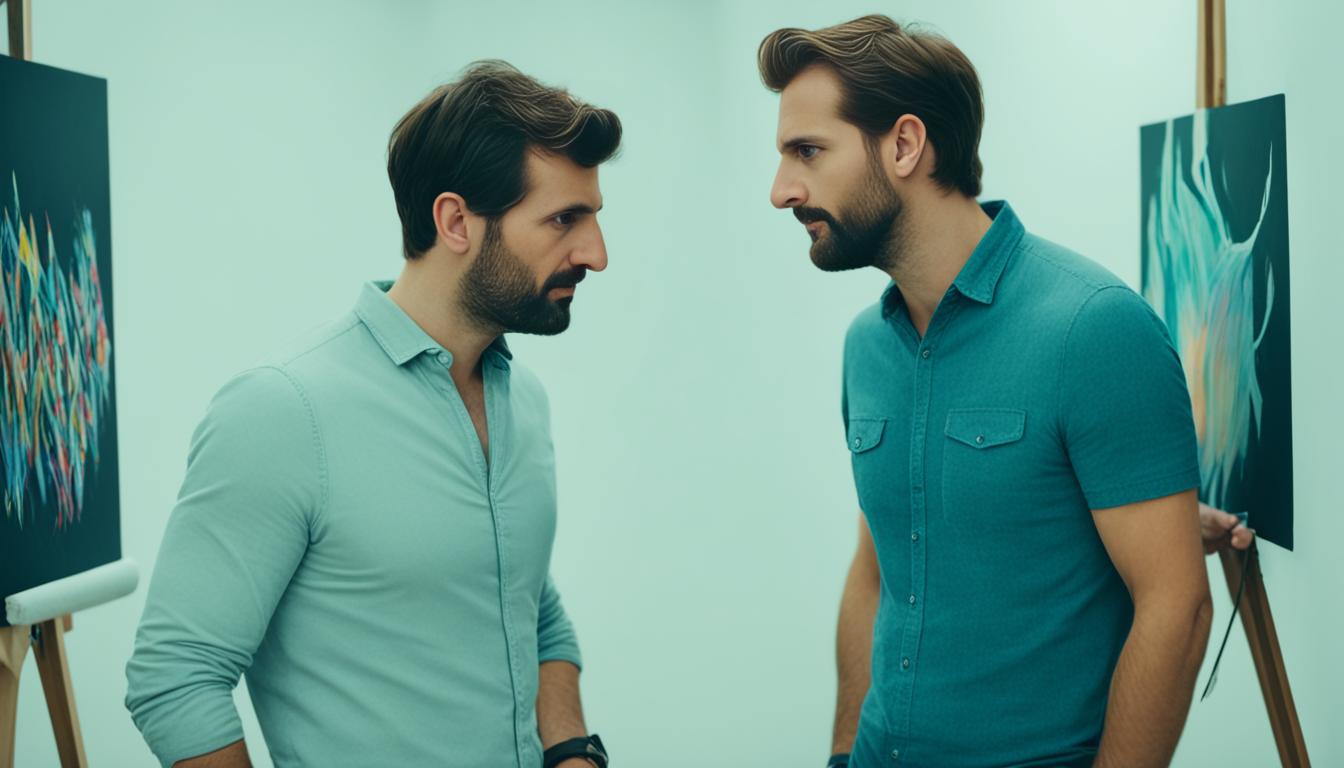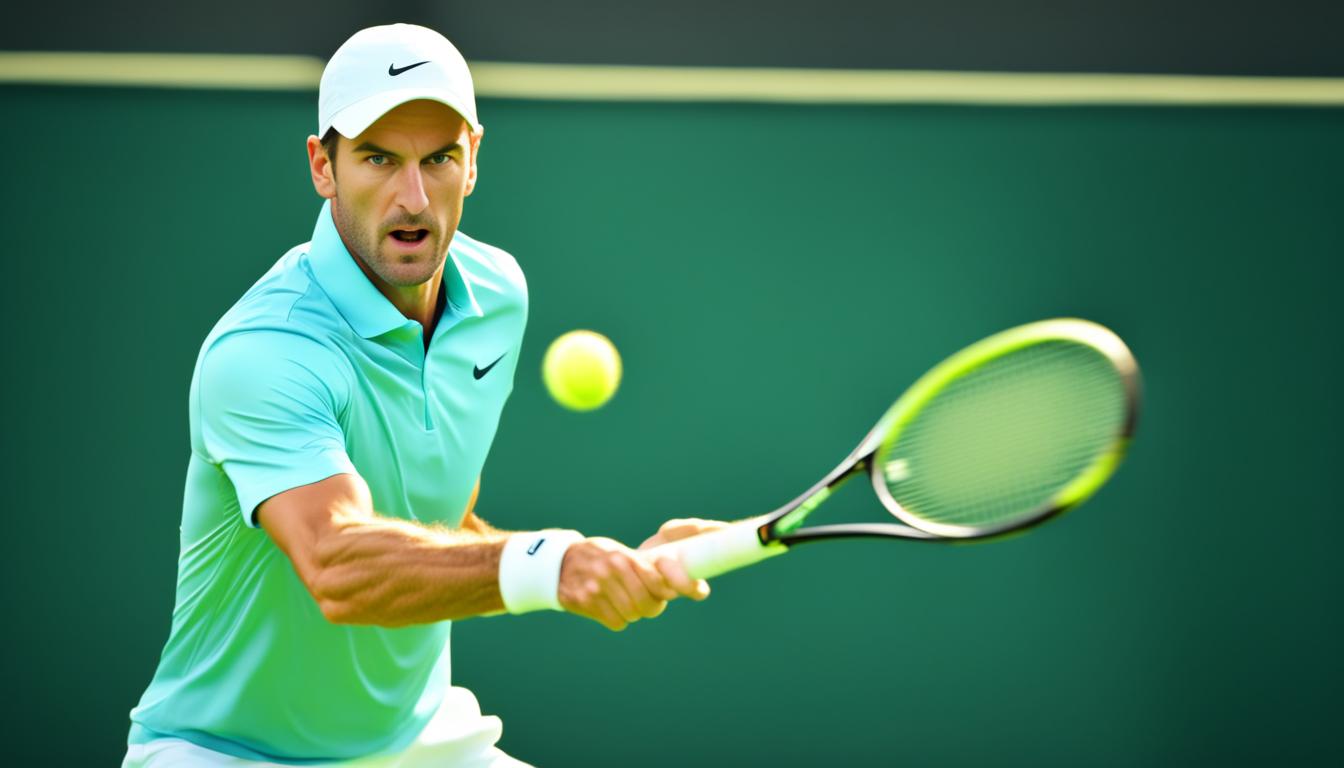Tennis is a captivating sport that requires a solid foundation of fundamental tennis strokes. Understanding the basic mechanics of tennis, including the kinetic chain that involves the lower body, core, upper body, and arm and racquet execution, is crucial for generating power and accuracy in your strokes. By mastering the five basic tennis strokes, which include the serve, forehand, backhand, volley, and overhead, you can elevate your game and improve your technique.
Whether you are a beginner looking to learn tennis techniques or an experienced player aiming to enhance your strokes, this guide will provide you with valuable tips and insights to develop efficient and powerful tennis hitting. From the tennis swing basics to tennis stroke development, we will cover all the essential elements you need to know to master your tennis strokes.
Key Takeaways:
- Understanding the basic mechanics of tennis and the kinetic chain is essential for generating power and accuracy in your strokes.
- Master the five fundamental tennis strokes: serve, forehand, backhand, volley, and overhead.
- Consistent practice and drilling are crucial for mastering tennis strokes and improving technique.
- Proper grip, stance, racquet preparation, and follow-through are essential for effective strokes.
- Focus on footwork, balance, and coordination to enhance the power and control of your strokes.
The Basic Mechanics of Tennis
The basic mechanics of tennis involve understanding how your body works together to generate power and accuracy. It’s a multi-step process that utilizes the kinetic chain, starting from the lower body and progressing all the way to the racquet execution and follow-through.
Let’s break down the basic mechanics of tennis step by step:
- Lower Body: The foundation of a powerful stroke starts with the lower body. It provides the necessary strength and stability for generating energy and transferring it upwards. Proper footwork, balance, and weight distribution play a crucial role in setting the stage for an effective shot.
- Core: The core acts as a powerhouse in the kinetic chain, converting the energy from the legs into rotational power. It’s the link between the lower body and the upper body, allowing for a seamless transfer of energy. A strong and engaged core provides stability and helps maintain control throughout the stroke.
- Upper Body: The upper body, including the torso and shoulders, plays a vital role in directing the energy generated by the lower body and core. It acts as a conduit, channeling the power from the core through the arms and into the racquet. Proper positioning and alignment of the upper body contribute to the accuracy and consistency of the stroke.
- Arm and Racquet Execution: The arm and racquet execution is the grand finale of the kinetic chain. It involves the coordinated movement of the arm and wrist to strike the ball with precision and power. The grip, swing path, and timing are key factors in executing a successful shot. Smooth follow-through ensures that everything went smoothly, maximizing power and setting you up for the next shot.
By understanding and mastering the basic mechanics of tennis, you can optimize your strokes and take your game to the next level. Let’s visualize the kinetic chain in action:
| Step | Component |
|---|---|
| 1 | Lower Body |
| 2 | Core |
| 3 | Upper Body |
| 4 | Arm and Racquet Execution |
The Serve: Initiating Play with Power
The serve is the fundamental stroke that initiates play in every tennis match. It requires a unique blend of technique and personal style, where the general motion is consistent but the nuances vary from player to player.
To master the serve, it’s important to adopt a good stance, practice consistent ball toss, and strike the ball overhead with accuracy and power. A good stance provides a solid foundation for a powerful and well-placed serve. Keep your feet shoulder-width apart, with your front foot slightly facing sideways and your back foot perpendicular to the net.
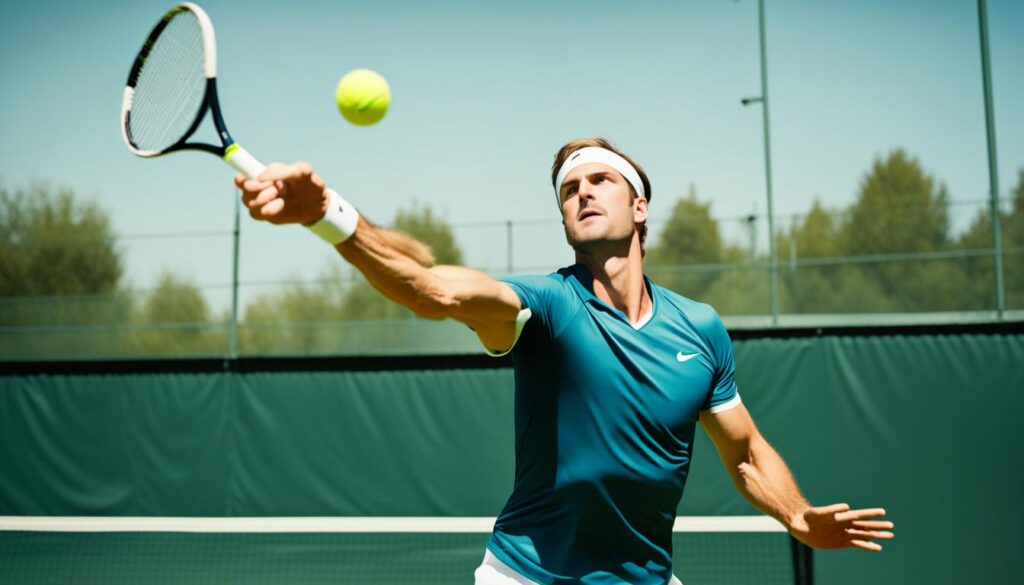
“The serve is the most important shot in tennis because it starts every point. It sets the tone for the game and can give you a significant advantage if executed well.”
The ball toss is another crucial element of the serve. Practice tossing the ball consistently to the desired height and location, slightly in front of your body. This allows you to reach the optimal contact point for a powerful serve. Striking the ball overhead with your racquet is the final step in executing a successful serve. Focus on a smooth swing motion, using your entire body to generate power and accuracy.
Common Mistakes to Avoid
- Avoid net serves by practicing consistent ball toss and ensuring proper racquet position at contact.
- Keep your body balanced and avoid leaning forward or backward during the motion.
- Don’t rush the serve—maintain a fluid and controlled motion throughout the entire stroke.
Serve Technique Tips
- Experiment with different grip styles, such as the continental grip, to find what feels most comfortable and effective for your serve.
- Focus on generating power from your legs, core, and arm coordination.
- Record and analyze your serve technique to identify areas for improvement.
- Practice serving from different court positions to develop versatility in your serve.
| Common Challenges | Tips for Improvement |
|---|---|
| Avoiding net serves | Practice consistent ball toss and focus on contact point and racquet position. |
| Lack of power | Engage your lower body, core, and arm coordination to generate more power in your serve. |
| Lack of accuracy | Work on consistent ball toss and practice hitting specific target areas on the court. |
The Forehand: Harnessing Power and Technique
The forehand stroke is often a player’s powerhouse, utilizing the strength of their dominant hand. It requires a blend of technique, timing, and body coordination. To develop a formidable forehand, it’s important to start with a proper grip and stance, such as a semi-western or eastern forehand grip, and stand with feet shoulder-width apart, knees slightly bent, and body side-on to the net. Racquet preparation and backswing are crucial for generating power, and contact and follow-through are important for accuracy and placement. For beginners, focusing on consistent footwork and controlled swing can help master the forehand stroke and add power and finesse to their game.
Proper technique is essential for executing a powerful and accurate forehand stroke in tennis. Let’s break it down step-by-step:
Grip and Stance
The first step to a great forehand is adopting a proper grip and stance. The two common grips used for the forehand are the semi-western grip and the eastern grip. The semi-western grip offers more topspin and power, while the eastern grip provides greater control and accuracy. Experiment with both grips to find the one that feels most comfortable and natural for you.
As for the stance, stand with your feet shoulder-width apart, knees slightly bent, and body side-on to the net. This position allows for greater stability and balance, enabling you to generate power and transfer your weight into the shot.
Racket Preparation and Backswing
Before making contact with the ball, it is crucial to prepare your racket and execute a proper backswing. Start by positioning your racket above the shoulder level, with the strings angled slightly backward. This position sets you up for a full and powerful swing.
As you initiate the backswing, rotate your torso and shoulders while keeping your arm relaxed and extended. This allows for maximum range of motion and generates power as you move into the forward swing.
Contact and Follow-Through
As you approach the ball, make sure to keep your eye on it and maintain a steady focus. When the ball reaches the ideal contact point, extend your arm forward and drive through the ball with a smooth, fluid motion. Aim to strike the ball slightly in front of your body for optimal power and accuracy.
After making contact, follow through with your swing, extending your arm and racket naturally towards your target. This follow-through helps control the shot and adds finesse to your forehand stroke.
Remember, consistent practice is key to mastering the forehand stroke. Focus on refining your footwork, timing, and technique to unleash the full potential of your forehand. As you continue to develop your skills, the forehand will become a reliable and powerful weapon in your tennis arsenal.
The Backhand: Versatility and Control
The backhand stroke is a crucial counterpart to the forehand, providing players with a versatile response to tennis balls on their non-dominant side. When it comes to the backhand, there are two main variations: the one-handed backhand and the two-handed backhand.
The one-handed backhand offers extended reach and effectiveness in managing close-to-body shots. It requires a proper grip, usually an eastern or continental grip, and a stance that allows for rotational power. The one-handed backhand emphasizes control and finesse, and it is often preferred for its elegance and shot variety.
The two-handed backhand, on the other hand, provides more control and stability, especially when dealing with high balls. It involves a grip where both hands grip the racket handle and a wider stance to accommodate the two-handed swing. The two-handed backhand is known for its consistency and power.
To choose between a one-handed and two-handed backhand, consider your personal preference and playing style. Some players gravitate towards the grace and artistry of the one-handed backhand, while others appreciate the stability and control of the two-handed backhand. It’s essential to experiment with both styles and focus on form to determine which one suits you best.
Mastering the backhand stroke requires not only the right grip and stance but also proper footwork, balance, and control of your swing. Practice drills that target backhand technique and incorporate footwork exercises to improve your overall backhand performance.
The Proper Grips for One-Handed Backhand and Two-Handed Backhand
| Backhand Type | Proper Grip |
|---|---|
| One-Handed Backhand | Eastern or Continental Grip |
| Two-Handed Backhand | One hand on the bottom of the handle (Dominant hand) and the other hand on top (Non-dominant hand) |
The Volley: Agility and Precision
The volley is a shot made before the tennis ball bounces, typically performed near the net. It requires agility, precision, and quick reflexes, with the motion focused on placement and timing rather than power. A compact backswing, contact point in front of the body, and solid footwork are key elements of a successful volley. The most commonly used grip for volleys is a continental grip. For beginners, practicing the ready position, improving hand-eye coordination, and focusing on a controlled follow-through can enhance volleying skills and make it a seamless part of their game.
| Key Elements of a Successful Volley |
|---|
| 1. Compact Backswing |
| 2. Contact Point in Front of the Body |
| 3. Solid Footwork |
| 4. Continental Grip |
The Overhead: Thrilling and Dominant
The overhead stroke in tennis is a powerful shot that often resembles a serve in its execution. It allows players to assertively finish off points and exude dominance on the court. Unlike the serve, the overhead doesn’t involve a ball toss but is about capitalizing on a high ball, usually near the net. Anticipation and positioning are key to a successful overhead, as well as proper contact and follow-through.
Anticipation: The ability to anticipate an incoming high ball is crucial for executing a successful overhead. By reading the ball’s trajectory and observing the opponent’s movement, players can position themselves optimally to make the shot.
Positioning: Proper positioning plays a significant role in executing an effective overhead. Players should move quickly and position themselves directly under the ball while maintaining balance and stability to ensure a solid shot.
Contact and Follow-through: When making contact with the ball, it’s essential to maintain a firm and controlled grip on the racket, ensuring a clean and powerful strike. After making contact, a smooth follow-through is vital to complete the stroke and maintain control over the ball’s direction.
Developing proficiency in the overhead stroke requires practice, coordination, and strategy. By honing anticipation skills, positioning oneself correctly on the court, and executing precise contact and follow-through, players can master this thrilling and dominant shot.
Here’s an example of a table showcasing the key elements of the overhead stroke:
| Element | Description |
|---|---|
| Anticipation | Reading the ball’s trajectory and opponent’s movement |
| Positioning | Moving quickly and positioning oneself under the ball |
| Contact | Maintaining a firm and controlled grip on the racket |
| Follow-through | Completing the stroke and maintaining control over the ball’s direction |
Practicing these key elements and incorporating them into your gameplay will help you dominate the court with powerful overhead strokes.
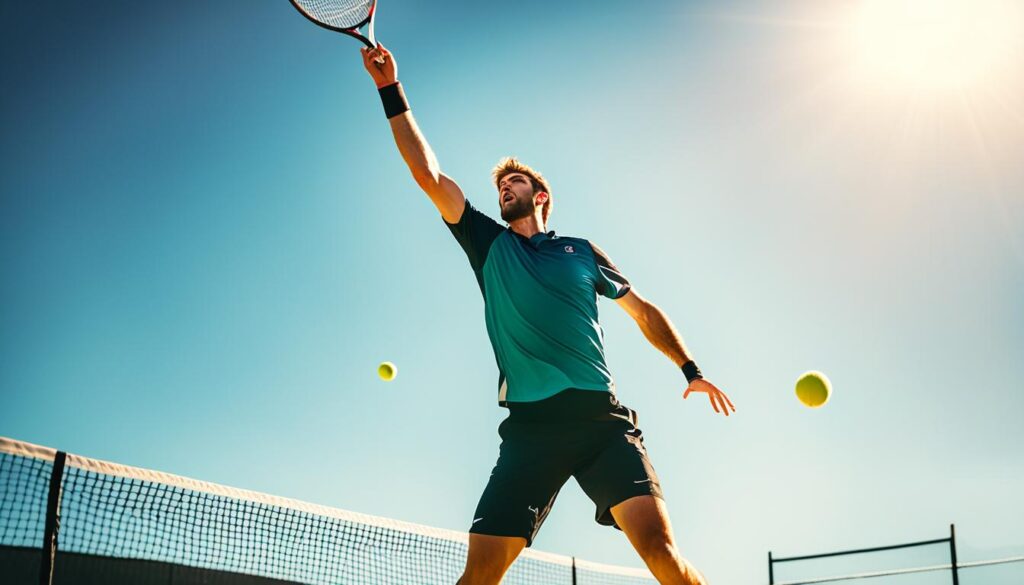
Conclusion
Mastering the fundamentals of tennis strokes is essential for elevating our game and becoming more efficient and powerful players. Understanding the basic mechanics of tennis, including the kinetic chain, is crucial for generating power and accuracy in our strokes. By mastering the serve, forehand, backhand, volley, and overhead, and consistently practicing good technique and footwork, we can improve our game and become more well-rounded players.
Improving our tennis techniques requires dedication and practice. By focusing on the tennis stroke fundamentals and consistently refining our skills, we can take our game to the next level. Whether it’s perfecting our serve for a powerful start, harnessing the strength and technique of our forehand and backhand, demonstrating agility and precision in our volleys, or asserting dominance with thrilling overhead shots, each stroke contributes to our overall performance.
With perseverance, we can continue to improve our tennis strokes and master the art of the game. Whether we aspire to compete at a high level or simply enjoy the sport recreationally, honing our skills will enhance our overall tennis experience and ensure a greater level of satisfaction on the court. So, let’s practice, refine, and strive to be the best tennis players we can be!
